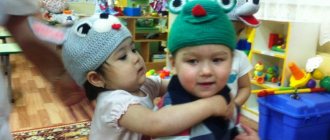Junior group. Early childhood, nursery. Children 1-4 years old
A card index of experimental games for children 2–3 years old. A card index of experimental games for children 2–3 years old. What are stones Purpose: to introduce children to stones of different shapes and textures; formation of classification principles; development of fine motor skills; identify the properties of the stone: heavy, hard, odorless. Material and equipment:…
Card index of didactic games and exercises with Dienesh blocks for the sensory development of young children 1. “Wonderful bag”
Goal: to consolidate the knowledge
young children Equipment: Bag, set of Dienesh blocks. Game progress: Option No. 1. All blocks are put into a bag. Ask your child to touch everything...
A selection of outdoor games for little ones
To plan your activity, use a selection of outdoor games that are great for toddlers. Alternate them to keep children's attention.
Hen and chicks
Goal: to develop motor activity, listening and hearing skills.
The teacher plays the role of a chicken, and the children play the role of chickens. Before the game starts, the teacher fences off the area for the “chicken coop”. To do this, he pulls a rope between two supports at a height of 55 cm. Then he scatters several toys in secluded places on the site.
The game begins with the “chickens” entering the “chicken coop” and the “hen” going to the playground in search of food. She walks slowly within the area. After a couple of minutes she says “Ko-ko-ko.” At this signal, the children crawl under the rope, run up to the teacher and together look for food (toys). When the teacher says “It’s time to go home,” the children run back to the “chicken coop.”
The exercise is repeated until the children find all the toys. If children cannot cope, the teacher can help.
Long throw
Goal: to develop accuracy and coordination of movements.
The teacher divides the kids into 3-4 teams. Then he draws a circle with a diameter of 1 meter and a line three meters from the circle. Gives each team 4 bags filled with sand. All children cross the line.
At the “Start” command, children take turns throwing the bags into the circle: 2 times with their right hand and 2 times with their left. Then they pick them up and pass them to the next player on their team. The team that completes the task the fastest and has the most shots inside the circle wins. The teacher makes sure that the children do not interfere with each other and counts how many bags from each team fall into the circle.
Crossing
Goal: to develop coordination of movements.
The teacher conventionally designates the two banks of the river by drawing them on the ground or with chalk on the asphalt. The distance between the banks is 5-7 meters. He places album sheets or pieces of plywood that look like bricks between them. Then he divides the children into teams and gives them the task: to cross from one bank to the other using “bricks”.
The teacher gives a signal, and the kids take turns starting to cross. He makes sure that there is no more than one person from the team at the crossing at the same time, and that the kids only step on the “bricks.” If someone steps on the “water”, he is removed from the race and begins to go through it again. The first team to cross to the other side wins.





